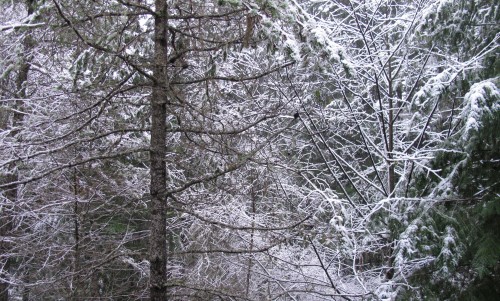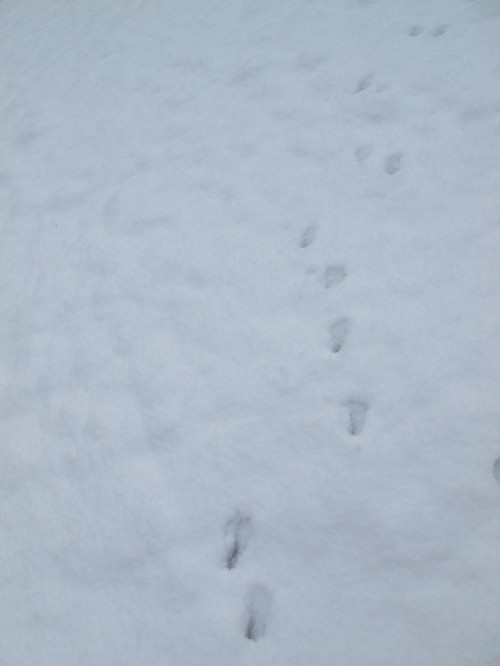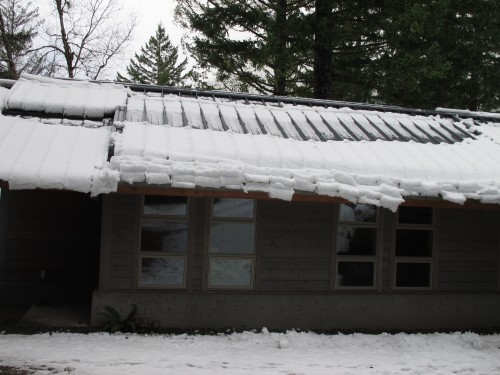A Winter Vocabulary Lesson

Hibernaculum (hi-buhr-NAK-yuh-luhm) (Latin, “tent for winter quarters”) can refer to:
- (zoology) The location chosen by an animal for hibernation. Commonly this may be a hibernating mammal or insect.
- (botany) A bud, case, or protective covering that a plant uses to survive the challenging environmental conditions during a dormancy period.
This winter, I’m living in a hibernaculum. There are 13 of us living at, or within four miles of, the Learning Center right now. Overwintering, you could call it. If you widen the circle to 25 miles, you add three more people.
It’s a unique experience, in both the social aspect of living in such a small community and the sheer isolation of living in the mountains off a winding snow-covered road. The same sixteen people are your co-workers, friends, entertainment, homework buddies, adventure partners. You get to know every side of every person and it’s almost impossible to keep anything secret.
But you know what? I kind of like it. You recognize every car you see on the road because the highway is closed just east of the Learning Center and the only people up here are those who live here. It’s quiet. Life moves at a slower pace. You have to schedule trips into town around the weather. It’s definitely not for everyone, but I feel lucky to be experiencing my second full winter in the mountains.
 Unidentified tracks in a fresh snow-pack
Unidentified tracks in a fresh snow-pack
Torpor (TOR-per) (Latin, “to be still”) can refer to:
- A state of mental or physical inactivity.
- A short-term state of lowered physiological activity typically characterized by reduced metabolism, heart rate, respiration, and body temperature that occurs in varying degrees.
We all know about hibernation, but torpor is less commonly talked about. In fact, some animals we think of as hibernating actually go into a state of torpor instead. Bears, for example. Hibernation comes with a lot of physical changes to an animal’s body—a very low temperature, heart rate, and metabolism are some of the big ones. Hibernation is also based on day-length and hormone levels, whereas torpor is based more on outside temperature. Animals in torpor often go into that state for short periods of time—hummingbirds, for instance, who often eat about every 20 minutes during the day, go into torpor at night to conserve energy.
Aestivation (ehs-ti-VAY-tion) (Also estivation) can refer to:
- The act of spending or passing the summer.
- (zoology) A state of dormancy or torpor during the summer.
- An inactive state resembling deep sleep, in which some animals living in hot climates pass the summer. Estivation protects these animals against heat and dryness. Compare to hibernation.
If I was a non-human animal, I would estivate. I kind of do it anyway, ask anyone who knows me. An abundance of hot sunny days makes me want to close the curtains and stay inside. Don’t get me wrong, I do like the sun and I love being outside, I would just rather have fewer sunny days and lower summer temperatures. I love it when there’s such a low, thick cloud cover that it’s dark all day. I love when the sun sets at 4:30 in the evening. I like cold, crisp sunny days in winter that make everything sparkle with ice.
I probably wouldn’t do so well in the desert. Similarly, some animals that live in really hot temperatures can’t survive in those temperatures without estivating. Reptiles, for example, use 90-95% less energy when they estivate during the day! At night, once it has cooled off, they wake up and go about their lives.
 Snow about to fall off a building at the Learning Center and become a roofalanche
Snow about to fall off a building at the Learning Center and become a roofalanche
Roofalanche (ROOF-al-anche) can refer to:
- The act of a large chunk of snow sliding off a roof due to its weight and the angle of the slope.
- Similar to Branchalanche (BRANCH-al-anche), a large piece or pieces of snow falling off of or out of a tree.
Hazards, it turns out, are everywhere. Just think of black ice. Living in an area with quite a few evergreen trees, sloping roofs, and lots of snow, is an adventure. Just walking out my front door I have to climb over a 5-foot tall mound of snow that has fallen off our roof, then turned to ice, making it nearly impossible to shovel a path through. And even if we did shovel a path, it would just happen again the next day.
Roofalanches, you can avoid by knowing where they are most likely to be and then not standing under those roofs. Branchalanches, however, are more complicated. You can’t tell when one is coming, it just happens. You might find yourself walking under a tree, then suddenly being hit by a cascade of snow, soaking your jacket and slipping down the back of your shirt. Best to wear a waterproof jacket with a hood on at all times.


Great blog-post. I miss living in snow country, surrounded by mountains and friends, living next to a lake, with new tracks in the morning, and a good cup of tea in the evening.
Nice post on Chattermarks. It was fun to read. Love you.